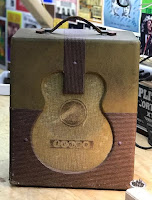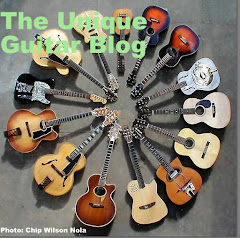 |
| World War II factory effort |
By the ‘50’s relations with Europe, and some Asian countries had normalized so products were being imported once again. Guitars were no exception. Most of the 1950 imported models were not up to Gibson, Fender, or Martin standards, but they filed a niche.
 |
| The Almanac Singers |
In the late 1950’s and early 1960’s, sales of acoustic guitar increased with the popularity of Folk Music.
 |
| The Beatles on the Ed Sullivan Show |
Then when the Beatles arrived in the United States in 1963, an incredible boon in guitar sales erupted, and it seemed that every kid in America just had to have a guitar.
 |
| '64 Kent by Guyatone |
Most of these instruments sold in the United States at the time were mamufactured in Japan, or South Korea, and then badged by the importer under the name of their choice. The distributors that imported these guitars played an important part in the history of the guitar, and related products.
One of the importers was Jack Westheimer’s W.M.I. company that imported Teisco guitars, and branded them under several different badges or brands.
 |
| '64 Kent Polaris Teisco |
One other company that distributed guitars, as well as other musical instruments was Tempo-Merson. This New York City based distributor was originally found by Mr. Bernie Mersky, and eventually a man named Ernie Briefel took control. Hence the name "Merson".
 |
| '50's Tempo by Kay |
Merson-Tempo had imported an acoustic electric guitar as early as the late 1940’s under the brand name; Merson. In 1948, Music Trades Magazine ran an advertisement for the Tempo Electric Spanish Guitar, that sold for $59.50 plus $11.50 for the “Dura-bilt” (probably cardboard) case.
 |
| '50's Tempo Amplifier |
Along with the guitar, a small amplifier was offered. It resembled a Premier amp, and was probably manufactured by the Multivox company of Manhattan. This amplifier had an 8” Alnico 5 speaker and came with volume and tone controls, and a pilot light. The grill cloth featured a classical guitar design with “Tempo” written on the guitar’s bridge.
 |
| '50's Favilla Guitar |
From around 1948 until the early 1960’s Merson, and Merson Tempo brand instruments were distributed mainly in the local New York area. The company also distributed instruments made by United States manufacturers such as Harmony, Favilla, Supro. and Kay, and sold them at wholesale cost to the retail outlets. But many of their instruments were of Asian origin.
 |
| From a 1960's Hagstrom Catalog |
The electronics on Hagstrom guitars in the 1960’s were all embedded in the pickguard and the guitar featured a very thin neck.
 |
| D'Aquisto model |
In the 1970’s, the Hagstrom company underwent some design changes by introducing The Swede, and another electric guitar designed by Jimmy D’Aquisto. Hagstrom was also the first company to introduce a guitar that could be used as a synth controller known as the Swede Patch 2000. This resulted from a joint venture with the Ampeg Corporation.
 |
| 1960's Giannini Classical Guitar |
Giannini guitars were also imported by Merson, and later Westbury/Unicord from Brazil. The Giannini Company is Brazil's largest guitar manufacturer and located in Sao Paulo. The initial Giannini imports were mostly student grade classical guitars, along with some Bazilian ethnic instrument, such as cavauinhos, vihuelas, vioalas, and flat back mandolins.
The popularity of the 12 string guitar was at an all time high in 1970, and that year Giannini introduced an unusual instrument called the Craviola. This unusual instrument was a guitar created by Brazilian guitarist, Paulinho Nogeuira. The Craviola has a unique kidney bean shaped body, and was meant to produce a sound similar to that of a harpsichord.
 |
| Giannini 12 string Craviola, the original version |
The 12 string version of the Craviola combined the feel of a guitar along with an ethnic instrument called a viola caipira. Giannini also offered this style in a six string version with steel strings and another with nylon strings. Led Zepplin guitarist, Jimmy Page, used the 12 string model on the recording Tangerine. He was given a six string, and a 12 string version by the company on a visit to Brazil.
 |
| Unicord portable tape recorder |
 |
| 1952 ad for Amplifier Corporation of America |
In 1967, in an attempt to cash in on the guitar boon, Gulf+Western Corporation purchased Unicord. By then Unicord had acquired Merson. Interestingly, this was the same year that CBS purchased the Fender company.
 |
| 1968 Univox U-458 guitar amp |
 |
| 1968 Lafayette amplifier |
A hobby company called Lafayette sold amplifier kits. These were actually manufactured by Univox, but came with a Lafayette badge.
 |
| Univox Hi Flyer |
Also in 1968 the Univox company produced a guitar they called The Hi-Flyer. This was an attempt to replicate a Mosrite Venture's Model. This instrument was made in Japan. There were several different versions, and it gained quite a following among those that could not afford a Mosrite instrument.
 |
| 1971 Univox Hi Flyer headstock |
Genuine Mosrites' have an angled headstock, with no truss rod cover, the Mosrite vibrato, and much better electronics.
 |
| 1973 Univox Lucite guitar |
Univox made replicas of Gibson Les Pauls and a replica of a Dan Armstrong lucite guitars. called Lucy.
 |
| 1971 Univox Badazz |
Another guitar called The Badazz, which was a copy of a Guild S100. Most of these instruments were actually manufactured by Aria.
 |
| Univox "Univibe" pedal |
In 1971 Univox began offering a series of effects pedals, and based on their relationship with Korg, they produced synthesizers. Probably the best know pedal was the Univibe, which was a chorus, flanger, phaser effects pedal.
 |
| Unicord "Stage" 400 two 10" |
By 1975 Univox and Merson went their separate ways. Merson or Tempo guitars were not manufactured after this year.
This same year Univox/Unicord switched all of its production from Westbury Long Island to Japan where they were manufactured by Matsumoku. Unfortunately, over night most of the employees lost their jobs. Only a small group remained to test imported amplifiers before they were sent to retailers.
 |
| Univox Westbury Performer |
The last guitar made under the Univox brand was called the Univox Westbury Performer. This came instrument came out in late 1976.
 |
| 1980's Westbury Deluxe guitar |
The original Merson owner, Ernie Briefel was hired as a consultant by Unicord. He went on to found “Music Tecnnologies Incorporated, which later became Music Industries Corporation. MTI imported guitars from Matsumoku under the Westone brand at the same time Unicord was offering it's Westbury guitars.
St. Louis Music eventually acquired Marshall Amplifiers, and the Korg Company, along with Merson/Unicord.
 |
| Marshall Super Lead MK II 100 watt |
He did not believe that the UK manufactured transformers could handle the full 100 watts from 6550 tubes with American 110 volt power. Marshall went on to manufacture its own transformers based on Unicords' design.































